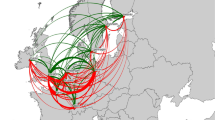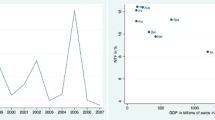Abstract
This paper studies the reasons why business cycles are more synchronized between some European economies than between others. It analyzes the cyclical co-movement of real GDP for 325 European country-pairs over the 1995–2018 period and finds that differences in industry composition can explain disparities in business cycle synchronization better than trade or financial linkages. The role of trade is studied by considering both bilateral trade intensity and common trade relationships with third countries. Bilateral financial integration is found to have a negative effect on GDP correlations, while sharing the euro has a positive but relatively small effect. However, the euro amplifies the negative effect of industry specialization on co-movement. The results also show that using more disaggregated sectorial data substantially increases the importance of differences in industry composition.
Similar content being viewed by others
Notes
The standard deviation is 22 %.
Clark and Wincoop (2001) find that a higher degree of specialization is one the reasons (although a minor one) why business cycles are more correlated between U.S. states than between European countries. However, the coefficient on specialization is not statistically significant when they control for other variables.
Pentecote et al. (2015) suggest a different channel through which trade can diminish synchronization. In their DSGE model, the effect of trade on co-movement is ambiguous. An increase in the volume of existing trade flows facilitates the transmission of shocks via changes in the terms of trade. However, if countries respond to shocks by producing and exporting new products, the impact of the shocks on the terms of trade is diminished, resulting in a negative relationship between bilateral trade volumes and co-movement.
Baxter and Kouparitsas (2005) find that bilateral trade has a significant effect on bilateral business cycle correlations even after controlling for exogenous gravity variables.
In the particular case of the West African Economic and Monetary Union (WAEMU), Zouri (2020) finds that their common currency does not have a significant effect on synchronization, although it may have an indirect effect by increasing bilateral trade.
In the non-overlapping panel data used in my analysis, the average cross-country correlation of output gaps is 16 % during 1995–2002, 72 % during 2003–2010 and 28 % during 2011–2018.
Although several papers have tried to identify different patterns for core and periphery EMU members, Campos and Macchiarelli (2021) warn that the classification of a country into core or periphery may change over time. They propose using a dynamic classification index that can take values over a continuum rather than a static binary classification.
See Kose and Yi (2006) for a discussion of the puzzle.
Real GDP is detrended using the Hodrick-Prescott filter.
In normality tests, the Jarque-Bera statistic is 0.59 (p = 0.74) in the benchmark cross-sectional equation and 4.90 (p = 0.09) in the benchmark panel equation.
For the construction of the 2-digit index, some sectors are grouped together because their individual value added is not available for all countries/years but their combined value added is. A few minor sectors for which data is not fully available have been omitted.
EXi→j stands for exports from country i to country j.
Bilateral trade data from more than 200 countries or autonomous territories is used to construct this index.
This variable is similar to one used in Dees and Zorell (2012), but they don’t divide by total holdings to normalize it.
POP stands for population.
Baxter and Kouparitsas (2005) use dummies to capture the effects of income per capita on business cycle co-movement. They use a dummy that equals 1 if both countries are industrialized countries and a dummy that equals 1 if both countries are developing countries. They find that both dummies are statistically significant.
Before 1999, the appreciation/depreciation rate is calculated relative to the European Currency Unit (E.C.U.).
GDP correlations are calculated using data from 96 quarters (24 years × 4 quarters).
Initial values serve as instruments because co-movement of real GDP during a period cannot influence bilateral trade, industry composition or GDP per capita at the beginning of that period. The IV regressions are perfectly identified (same number of instruments as endogenous variables).
Most articles in the literature use cross-sectional regressions, including Baxter and Kouparitsas (2005), Clark and Wincoop (2001), Davis (2014), Dees and Zorell (2012), Imbs (1999), Imbs (2004), Kalemli-Ozcan et al. (2001), Kalemli-Ozcan et al. (2013), Kose and Yi (2006), Otto et al. (2001), and Rose and Engel (2002).
Dividing the sample period into a few non-overlapping sub-periods is quite common in the literature. For example, Clark and Wincoop (2001) use 2 sub-periods of 17 years, Frankel and Rose (1997) use 4 sub-periods of 8.75 years, Frankel and Rose (1998) use 4 sub-periods of 8.75 years and 2 sub-periods of 17.5 years, Kalemli-Ozcan et al. (2013) use 6 sub-periods of 5 years, and Mejia-Reyes at al. (2019) use 3 sub-periods of 5 years.
Of course, this includes the direct effects and the indirect effects (via association with other variables) of these factors on synchronization.
Clark and Wincoop (2001) do not find the specialization index to be statistically significant when using value added instead of employment.
Azcona (2019) also finds a high explanatory power of industry composition in a group of EMU members using an index with 62 sectors.
The correlation coefficient between bilateral trade and the export index is -66 % in levels and − 87 % in logs.
In univariate regressions the effect is positive, but that may be because financial integration is correlated with other factors than increase synchronization.
In regressions (10f) and (10m) it only adds about 3 % to the explanatory power of a model with just period fixed effects.
Whether the euro contributes to increase the correlation of business cycles within Europe relative to the correlation between European and non-European economies cannot be tested with this data set.
In regressions not reported here I also estimate the interaction effects between the euro and financial integration and between the euro and differences in export markets. They are not statistically significant.
Table 7 reports the estimated value of the sum of coefficients, the corresponding standard errors and the results from separate Wald tests for each restriction. In all cases, the full effects for country-pairs within the EMU are statistically different from zero (*** indicate that the p-values from the Wald tests are smaller than 1 %).
References
Azcona N (2019) Specialization and business cycle co-movement in the euro area. Atl Econ J 47(2):193–204
Baxter M, Kouparitsas M (2005) Determinants of business cycle co-movement: a robust analysis. J Monet Econ 52(1):113–157
Belke A, Domnick C, Gros D (2017) Business cycle synchronization in the EMU: core vs. periphery. Open Econ Rev 28(5):863–892
Campos N, Macchiarelli C (2021) The dynamics of core and periphery in the european monetary union: a new approach. J Int Money Finance 112:1–18
Cesa-Bianchi A, Imbs J, Saleheen J (2019) Finance and synchronization. J Int Econ 116:74–87
Clark T, Wincoop E (2001) Borders and business cycles. J Int Econ 55(1):59–85
Davis JS (2014) Financial integration and international business cycle co-movement. J Monet Econ 64(C):99–111
De Grauwe P, Ji Y (2017) The international synchronization of business cycles: the role of animal spirits. Open Econ Rev 28(3):383–412
Dees S, Zorell N (2012) Business cycle synchronization: disentangling trade and financial linkages. Open Econ Rev 23(4):623–643
Drozd L, Kolbin S, Nosal J (2021) The trade-comovement puzzle. Am Econ J Macroecon 13(2):78–120
Duval R, Li N, Saraf R, Seneviratne D (2016) Value-added trade and business cycle synchronization. J Int Econ 99(C):251–262
Ferreira-Lopes A, Pina A (2011) Business cycles, core, and periphery in monetary unions: comparing Europe and North America. Open Econ Rev 22(4):565–592
Frankel J, Rose AK (1997) Is EMU more justifiable ex post than ex ante? Eur Econ Rev 41(3):753–760
Frankel J, Rose AK (1998) The endogeneity of the optimum currency area criteria. Econ J 108(449):1009–1025
Gachter M, Riedl A, Ritzberger-Grunwald D (2012) Busines cycle synchronization in the euro area and the impact of the financial crisis. Monetary Policy Econ 2:33–60
Grigoras V, Stanciu IE (2016) New evidence on the (De)Synchronization of business cycles: reshaping the european business cycle. Int Econ 147:27–52
Hall S, Lagoa S (2014) Inflation and business cycle convergence in the euro area: empirical analysis using an unobserved component model. Open Econ Rev 25(5):885–908
Imbs J (1999) Co-fluctuations. CEPR discussion paper no. 2267. Center for Economic Policy Research: London, UK
Imbs J (2004) Trade, finance, specialization, and synchronization. Rev Econ Stat 86(3):723–734
Imbs J (2006) The real effects of financial integration. J Int Econ 68(2):296–324
Johnson R (2014) Trade in intermediate inputs and business cycle comovement. Am Econ J Macroecon 6(4):39–83
Kalemli-Ozcan S, Sorensen BE, Yosha O (2001) Economic integration, industrial specialization, and the asymmetry of macroeconomic fluctuations. J Int Econ 55(1):107–137
Kalemli-Ozcan S, Sorensen BE, Yosha O (2003) Risk sharing and industrial specialization: regional and international evidence. Am Econ Rev 93(3):903–918
Kalemli-Ozcan S, Papaioannou E, Peydro J-L (2013) Financial regulation, financial globalization, and the synchronization of economic activity. J Financ 68(3):1179–1228
Kollmann R (2019) Explaining international business cycle synchronization: recursive preferences and the terms of trade channel. Open Econ Rev 30(1):65–85
Kose M, Yi K-M (2006) Can the standard international business cycle model explain the relation between trade and comovement? J Int Econ 68(2):267–295
Krugman P (1991) Geography and trade. MIT Press, Cambridge
Lane P, Milesi-Ferretti G (2001) The external wealth of nations: measures of foreign assets and liabilities for industrial and developing countries. J Int Econ 55(2):263–294
Liao W, Sanatacreu AM (2015) The trade comovement puzzle and the margins of international trade. J Int Econ 96(2):266–288
Mejia-Reyes P, Diaz-Carreño MA, Aroca P (2019) Mexican States’ business cycles co-movement over the period 2000–2014. A panel data model estimation. Growth Chang 50(4):1532–1567
Mundell RA (1961) A theory of optimum currency areas. Am Econ Rev 51(4):657–665
Otto G, Voss G, Willard L (2001) Understanding OECD output correlations. RBA research discussion papers 2001-05. Reserve Bank of Australia, Sydney
Pentecote J-S, Poutineau J-C, Rondeau F (2015) Trade integration and business cycle synchronization in the EMU: the negative effect of new trade flows. Open Econ Rev 26(1):61–79
Rose AK, Engel C (2002) Currency unions and international integration. J Money Credit Bank 34(4):1067–1089
Weyerstrass K, van Aarle B, Kappler M, Seymen A (2011) Business cycle synchronisation with(in) the euro area: in search of a ‘Euro Effect’. Open Econ Rev 22(3):427–446
Zouri S (2020) Business cycles, bilateral trade and financial integration: evidence from economic community of West African States (ECOWAS). Int Econ 163:25–43
Author information
Authors and Affiliations
Corresponding author
Additional information
Publisher’s Note
Springer Nature remains neutral with regard to jurisdictional claims in published maps and institutional affiliations.
The author would like to thank the editor (George Tavlas) and two anonymous referees. This article greatly benefited from their feedback and suggestions.
Rights and permissions
About this article
Cite this article
Azcona, N. Business Cycle Co-Movement in Europe: Trade, Industry Composition and the Single Currency. Open Econ Rev 33, 121–139 (2022). https://doi.org/10.1007/s11079-021-09625-7
Accepted:
Published:
Issue Date:
DOI: https://doi.org/10.1007/s11079-021-09625-7




